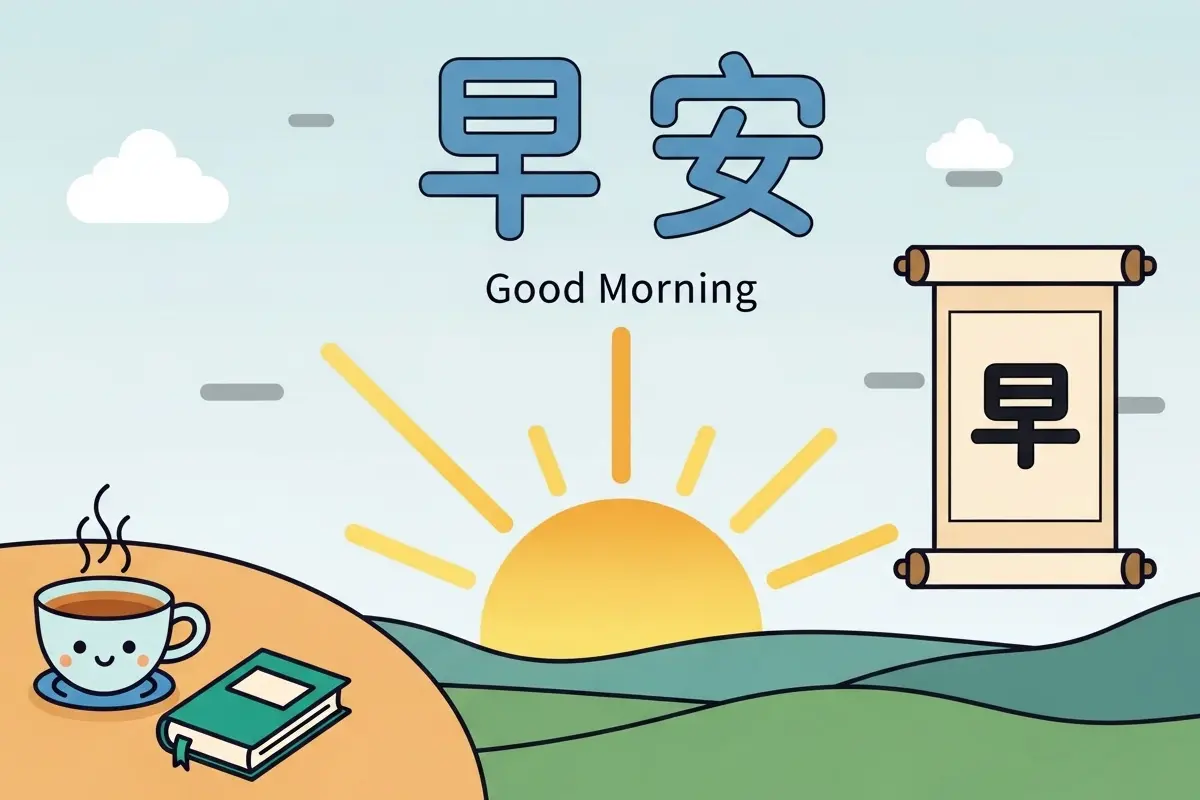
TL;DR
- “Good morning” in Mandarin Chinese is 早上好 (zǎo shàng hǎo).
- Formal version: 早安 (zǎo ān); casual version: 早 (zǎo).
- Use before 10 a.m. and pair it with a smile or nod.
- You can say 您早 (nín zǎo) for respectful greetings to elders.
- Tones matter — each syllable changes the meaning if pronounced incorrectly.
What Does “Good Morning in Mandarin Chinese” Mean?
The most common way to say “good morning in Mandarin Chinese” is 早上好 (zǎo shàng hǎo).
It literally translates to “morning good,” following Chinese word order.
Here’s the breakdown:
| Character | Pinyin | Meaning | Tone |
|---|---|---|---|
| 早 | zǎo | morning / early | 3rd tone |
| 上 | shàng | up / above | 4th tone |
| 好 | hǎo | good | 3rd tone |
Together, 早上好 (zǎo shàng hǎo) is the polite and natural morning greeting you can use in most contexts — from the office to casual chats.
💡 Pro tip: Avoid saying it after 10 a.m. Instead, switch to 你好 (nǐ hǎo) — meaning “hello.”
Other Ways to Say Good Morning in Mandarin
Chinese greetings vary by region, tone, and formality. Here are the main variations you’ll encounter:
| Expression | Pinyin | English Meaning | Usage |
|---|---|---|---|
| 早上好 | zǎo shàng hǎo | Good morning | Neutral, all-purpose |
| 早安 | zǎo ān | Peaceful morning / good morning | More formal, common in Taiwan |
| 早 | zǎo | Morning! / Hi! | Informal, casual with friends |
| 您早 | nín zǎo | Good morning (respectful) | Polite greeting to elders or superiors |
| 上午好 | shàng wǔ hǎo | Good late morning | Around 9–11 a.m., polite tone |
Each version suits a different tone or relationship — from business meetings to café conversations.
When and How to Use Each Greeting?
Mandarin speakers adjust greetings based on context and timing.
Use these tips for natural fluency:
- 早上好 → between 6–9 a.m., friendly and neutral.
- 早安 → formal tone; used in written messages or news broadcasts.
- 早 → short, cheerful version — common among friends or coworkers.
- 您早 → polite; say to teachers, elders, or clients.
- 上午好 → use between 9–11 a.m. for later morning hours.
👉 Want to practice your timing and tone? Try it in our AI tutor in How to Learn Chinese Fast.
Pronunciation and Tone Guide for 早上好
Tone accuracy is key when saying 早上好 (zǎo shàng hǎo).
Mandarin has four tones that change meaning entirely.
| Word | Tone | Sound Description |
|---|---|---|
| 早 (zǎo) | 3rd | falling-rising tone |
| 上 (shàng) | 4th | sharp falling tone |
| 好 (hǎo) | 3rd | dipping tone |
🎧 Practice by repeating slowly:
zǎo shàng hǎo → 3rd, 4th, 3rd tone rhythm.
You can visualize these tone curves interactively with Avatalks’ Character Pinyin Tool.
Cultural Etiquette When Greeting in Mandarin
Greeting customs in Chinese culture are subtle but meaningful.
Here’s how to say “good morning” naturally:
- Smile or nod gently when greeting.
- Use 您早 (nín zǎo) when showing respect.
- Avoid handshakes in informal situations unless initiated.
- Don’t overuse greetings with the same person — one sincere “good morning” is enough.
- Combine greetings with polite phrases like:
- 早上好,今天怎么样?(Good morning, how’s your day?)
- 您早,身体好吗?(Good morning, how’s your health?)
Learning these patterns helps you sound friendly, not mechanical.
Common Mistakes to Avoid
- ❌ Saying 早上好 after 11 a.m.
- ❌ Pronouncing “zǎo” with a flat tone — it changes the meaning.
- ❌ Using “早安” in Mainland China casual chats — it sounds too formal.
- ❌ Translating “good morning” word-for-word from English syntax.
✅ Focus instead on tone flow, time awareness, and cultural context.
Mini Dialogue Examples
Example 1 — Friendly setting:
A: 早!(Zǎo!)
B: 早上好!今天真冷。
(Morning! Good morning! It’s really cold today.)
Example 2 — Formal workplace:
A: 您早,王老师!
B: 您早!今天有会议吗?
(Good morning, Professor Wang! / Morning! Is there a meeting today?)
Example 3 — Polite encounter:
A: 早安!祝你有美好的一天。
(Good morning! Wish you a beautiful day.)
For more natural daily exchanges, see How Are You in Mandarin.
FAQs About Saying Good Morning in Mandarin Chinese
Q1: What is the most common way to say good morning in Mandarin?
The most natural phrase is 早上好 (zǎo shàng hǎo) — used in both formal and casual situations.
Q2: How do you say good morning politely?
Use 您早 (nín zǎo) or 早安 (zǎo ān) when speaking to elders, teachers, or clients.
Q3: What’s the difference between 早安 and 早上好?
早安 is more literary and formal (common in Taiwan), while 早上好 is conversational and standard in Mainland China.
Q4: Can I just say 早?
Yes — 早 (zǎo) is casual, like saying “Morning!” to friends or coworkers.
Q5: How can I practice tones effectively?
Listen and repeat with slow-speed audio or AI tools like Avatalks’ pronunciation mode to master rhythm and melody.